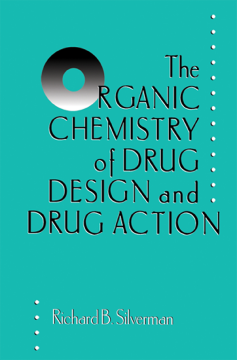
Additional Information
Book Details
Abstract
This is a new approach to the teaching of medicinal chemistry. The knowledge of the physical organic chemical basis of drug design and drug action allows the reader to extrapolate to the many related classes of drugs described in standard medicinal chemistry texts. Students gain a solid foundation to base future research endeavors upon: drugs not yet developed are thus covered!
n Emphasizes the use of the principles of physical organic chemistry as a basis for drug design
n Discusses organic reaction mechanisms of clinically important drugs with mechanistic schemes
n Uses figures and literature references extensively throughout
n This text is not merely a "compilation of drugs and uses," but features selected drugs as examples of the organic chemical basis for any and all drug design applications
"This book is a tour de force in the title area....This book adopts a novel format that focuses on the rational chemical underpinnings to both drug discovery and drug development. It seeks to illuminate the workings of drugs at the molecular level. Thus, this book contrasts with the traditional presentation which is organized around various classes of drugs....This book would be appropriate for advanced undergraduate students and graduate students and would probably be well suited as a text for course applications, especially at the graduate level. It is strongly recommended to scientists who are seeking an efficient introduction to medicinal chemistry, background in a specific drug principle or category, or a dose of inspiration."
--Bruce E. Maryanoff, R.W. Jouhnson Pharnaceutical Research Institute, JOURNAL OF THE AMERICAN CHEMICAL SOCIETY, Vo. 115, No.12, 1993
"For the first time the principles of medicinal chemistry/pharmacology are collected in a unified, well-organized and clearly presented fashion. It is so clearly written that it will be of value to both students and veteran scientists...My congratulations to Dr. Silverman in consolidating such a multiplicity of facts and data so as to truly begin to reduce medicinal chemistry from a hybrid of chemistry, pharmacology and related sciences to a single, clearly defined, rationalized discipline."
--CARL KAISER, Ph.D., Director, Medicinal Chemistry, NOVA PHARMACEUTICAL CORPORATION
"The author shows an uncanny ability to present the salient principles in a systematic, well-balanced and logical way...The book will turn out to be very popular with students because the material is presented clearly...The numerous superb illustrations included are used very effectively by the author to communicate and/or clarify concepts and ideas."
--William C. Groutas, Ph.D., Professor of Chemistry, WICHITA STATE UNIVERSITY
"I find [Chapter 8] to be an unusually comprehensive, clear and well organized discussion on prodrugs. Although the concepts are complex, they are presented in a logical, easily understood format. Dr. Silverman's use of schematics to illustrate both chemical and biochemical principles is especially effective and should be easily comprehended by the intended audience. I found myself reading for interest and enjoyment rather than searching for mistakes. The references are focused and current. It should become a standard text in short order."
--Anthony A. Sinkula, Ph.D., THE UPJOHN COMPANY
"I was favorably impressed with the clarity of Dr. Silverman's writing style which made the material interesting and easy to read...Treatment of the material is quite comprehensive without being overly detailed and the referencing and illustrations are well chosen and at about the right level."
--John G. Topliss, Ph.D., PARKE-DAVIS
"This book emphasizes the organic chemical aspects of medicinal chemistry....The organization of this book and the clarity of presentation are outstanding....The book very clearly presents medicinal chemistry as a unified discipline based on sound principles of organic chemistry. It is highly recommended to medicinal chemists as well as to all others entering into the field or concerned with the science of medicinal chemistry."
--JOURNAL OF MEDICINAL CHEMISTRY
